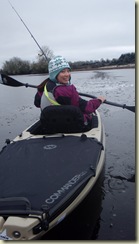
Last Sunday (21st Feb ‘10), despite the return of the cold weather, Wai Har, Niall “Macker” McCrea, John Henry and myself had made plans to head out on our first kayak fishing trip to see what all the fuss is about. As most of us come from a predominantly river/white-water background, Niall was delegated as leader being the only one who actually fishes on a regular basis.
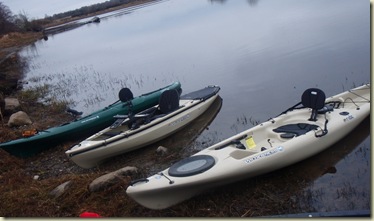 To help us in our quest, we decided to take the new fleet of Wilderness Systems Angling Kayaks for a test run to see how they compare and to see what conditions suit each different craft. The 3 Kayaks we had to test were (from left): Tarpon 140 (green), Commander 120 (sand) and Ride 135 (sand).
To help us in our quest, we decided to take the new fleet of Wilderness Systems Angling Kayaks for a test run to see how they compare and to see what conditions suit each different craft. The 3 Kayaks we had to test were (from left): Tarpon 140 (green), Commander 120 (sand) and Ride 135 (sand).
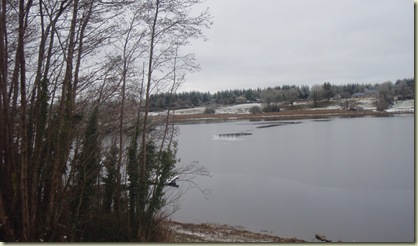 For location, we chose a small secluded lake outside Roosky which is reasonably sheltered and has good road access. Thankfully the day we chose had little to no wind which meant the lake was glassy flat. Unfortunately, it turned out to be exceptionally cold with the centre of the lake having a thin crust of ice to paddle through.
For location, we chose a small secluded lake outside Roosky which is reasonably sheltered and has good road access. Thankfully the day we chose had little to no wind which meant the lake was glassy flat. Unfortunately, it turned out to be exceptionally cold with the centre of the lake having a thin crust of ice to paddle through.
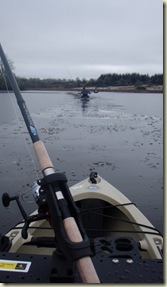 To start with, Wai Har took the Commander, Niall took the Ride, John had his open canoe and I took the Tarpon.
To start with, Wai Har took the Commander, Niall took the Ride, John had his open canoe and I took the Tarpon.
The Tarpon, being the longest kayak on test was naturally the fastest. The Tarpon series are fast, high performance sit on tops (SOTs) which are available in much longer lengths and tend to be considerably narrower than most other SOT makes and models. The Tarpon 140 makes a great tourer with the ability to cover long distances with ease and at a fast cruising pace. Once you get the kayak moving, it naturally wants to keep going and going. Turning is surprisingly good especially for such a long kayak and stability is reasonable too. However compared to the other kayaks on test, this has the narrowest beam and would therefore be the least stable of the three. John commented that even though he could paddle it easily, he would prefer more stability for when the kayak is stationary and in fishing “mode”. Storage in the Tarpon 140 is immense and the central hatch is great for storing spare rods and split paddles inside which are still easily accessible from the seating position. Either side of the hatch are small pockets which are also great for small accessories/tools that need to be in easy reach. The new seating system introduced last year is very comfy and offers good back/thigh support thanks to the height adjustable backrest and seat pad.
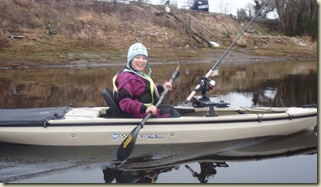 Wai Har jumped in the newest model in the fleet: The Commander 120. At 12ft it was also the shortest kayak but even so it still offers tons of carrying and storage capacity. This is also different from the other two Wilderness Kayaks as in it is more of a “Sit In Top” rather than a Sit On Top. The seating position is lower than normal and the sides of the kayaks come higher around the paddler which gives a more enclosed feeling. This feature is probably its biggest strength but also its biggest drawback.
Wai Har jumped in the newest model in the fleet: The Commander 120. At 12ft it was also the shortest kayak but even so it still offers tons of carrying and storage capacity. This is also different from the other two Wilderness Kayaks as in it is more of a “Sit In Top” rather than a Sit On Top. The seating position is lower than normal and the sides of the kayaks come higher around the paddler which gives a more enclosed feeling. This feature is probably its biggest strength but also its biggest drawback.
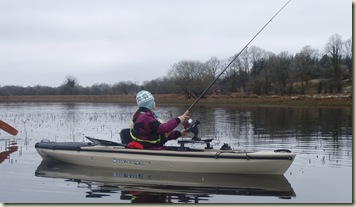 I think it’s fair to say we all really enjoyed paddling the Commander. First impressions of being big, bulky and slow are quickly dispelled revealing a nimble, stable and manouverable kayak. Wai Har being the smallest of all the paddlers out today, managed brilliantly and got lost in her own little world both paddling thru the ice and also when casting for fish. The SlideTrax mounting system means that rod holders and the accessory board can be mounted at a convenient position from the paddler. The seating system was the comfiest of all the kayaks although the slide-locking system was a little finicky (especially with cold fingers). Standing up in the Commander proved very stable which would make accessing the stern and bow areas for storage very easy and even casting while standing is an option.
I think it’s fair to say we all really enjoyed paddling the Commander. First impressions of being big, bulky and slow are quickly dispelled revealing a nimble, stable and manouverable kayak. Wai Har being the smallest of all the paddlers out today, managed brilliantly and got lost in her own little world both paddling thru the ice and also when casting for fish. The SlideTrax mounting system means that rod holders and the accessory board can be mounted at a convenient position from the paddler. The seating system was the comfiest of all the kayaks although the slide-locking system was a little finicky (especially with cold fingers). Standing up in the Commander proved very stable which would make accessing the stern and bow areas for storage very easy and even casting while standing is an option. 
Now the drawbacks. The first thing I noticed the Commander as needing is a bung. As this is a single skin Sit In Top, it has no internal drainage, so emptying, even on dry land proves tricky. As the sides/gunwales wrap around at the top, water pools on the inside of the kayak (even when upside down) and can only be got rid of with a sponge.
The fact that there is no internal drainage also limits the extremity of conditions it is feasible to paddle the Commander in. Paddling out through even a moderate beach-break or swell would be difficult if not impossible. And the possibility of becoming swamped with water would be very serious indeed making a bilge pump and/or bailer an essential accessory item to carry.
That’s it for Part 1. Stay tuned for Part 2 when we review the Ride 135 and also a Prospector Canoe!

